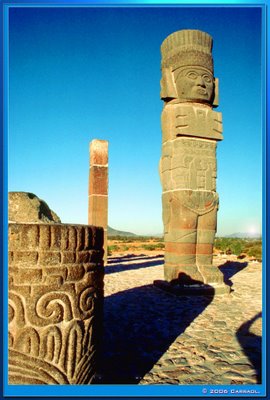
Kings, Warriors or Gods
The Atlantes at Tula are four colossal statues almost five meters in height which were discovered in a pyramid located in the archaeological zone of Tula, Hidalgo, located 40 miles from Mexico City.
Some legends tell that the Toltecs, after mysteriously abandoning the city of Teotihuacan, built a replica that would later become the capital of Toltec culture. This city was named Tollan, which for many years was ruled by a dynasty of kings, priests and warriors, descendents of Quetzalcoatl (the feathered serpent, ancient god of Teotihuacan and protector of culture and civilization). Such is the case of Toptzin, who ascended the Toltec throne, took the name of Quetzalcoatl and consecrated himself to its service. The name of Quetzalcoatl as god and Quetzalcoatl as king is said to have caused much confusion throughout Mexican history.
In present day the city of Tollan is known for its great pyramid Tlahuizcalpantecuhtli, or The Temple of The Morning Star, whose summit holds the famous Atlantes of Tula. They are representations of gods, warriors or Toltec kings that are believed to have been the pillars of a former wooden roof on the temple. One can climb up this pyramid to observe the Atlantes up close and appreciate the complex archeological treasures.
The Atlantes of Tula measure approximately 4.96 m in height by 90 cm in width. Each one is formed by four sections or blocks of wood that represent human figures. The first section represents the head, which is found covered by a headdress of feathers. The second and third sections form what would be the body, and the fourth and last were the legs and feet. It is worth mentioning that only a few of these statues have survived the passage of time, so several of them have been restored.
In regard of the “clothing” of these colossuses, the objects of great size that appear over the ears of the figures grab the attention; the chest is covered by a great plaque with the figure of a human being. The Atlantes also show anatomical differences in their faces despite maintaining the same expression, which bestows each one with a unique personality. Warriors, kings, gods and more are some classifications used to identify the Atlantes. Each one of the Atlantes holds an object in its right hand. It is known that the Toltecs were an artistic, wise and cultured people, but they were also warriors. Among their weapons was the Atl-Atl, which shot darts and arrows with lightly curved edges; however, according the current knowledge and discoveries made up to this moment, the Toltecs brandished the Atl-Atl in the left hand and not in the right like the figures of the Atlantes appear to be doing. In one of the pillars found next to the giant figures, appears the figure in relief of an individual who carries on his back a backpack or container with a sort of flame shooting out a stone. This has led some to suppose that the object the Atlantes carry is a flame thrower or blowtorch.
The legends also tell that the Toltecs, in their march toward the south led by Quetzalcoatl, arrived at Chichen-Itza (an archeological zone located in the Yucatan Peninsula) where they built a new capital fusing with the Mayan culture and tradition. The city of Tollan, in its age of decadence in the 13th century, was occupied by the Aztecs who came from the North.
The archeological zone of Tula gives visitors the opportunity to appreciate in an instant a chapter of the glorious past of the Toltecs. Despite the fact that this zone is not considered one of the most important in Mexico, it is worth visiting the city of Tollan, which has a great relevance in the history of Mesoamerica and constitutes a link in the chain of civilization of the central high plateau of Mexico.
Information was taken from “A Guide to Unknown Mexico No. 62 Hidalgo,” Sept. to Oct. 2000.
(Under construction)



